Ellis,J. Pressure transients in water engineering, A guide to analysis and interpretation of behaviour
Подождите немного. Документ загружается.

sewage pumping scheme, transient analysis indicated that a flywheel
moment of inertia ¼150 kg.m
2
was necessary to prevent vacuum
pressures in a glass reinforced plastic (GRP) main 1056 m long and
350 mm diameter. The pump motors already on order could accelerate
a total inertia only 12.7 kg.m
2
. This limitation rendered the flywheel
option impractical. A change to a more complicated starting switch
arrangement would have been necessary.
The resulting size and weight increase following addition of a flywheel
requires careful study of station loading and structural vibration. Extra
bearings may be necessary, particularly in the case of vertical pumps.
Since the flywheel is usually installed between the motor and the
pump, should the impeller become uncoupled from its shaft the flywheel
will be rendered ineffectual. Again, if a pump blockage should occur the
flywheel will be unable to suppress the subsequent transient. A loss of
pump prime will render the flywheel ineffective. Other considerations
include available space within the pumping station and practicality of
fitting the flywheel to a particular pumpset arrangement. Other
penalties associated with a flywheel installation are power losses in
motor windage and an uprated starting arrangement. Finally, the
attitude of the client towards the flywheel as a means of transient
suppression may be an important factor.
Having decided to install a flywheel, calculations of the continued
flow after trip are important to ensure that sufficient reserve volume
remains within a wet well. Suppose a pump is tripped normally at its
stop level. The extra pumping that occurs with the flywheel added
will continue to draw liquid from the wet well at levels below
minimum operating level. The consequent reduction in well level
may start to draw air into the pump suction. This should be avoided.
11.4 Pipeline limitations
Manuel (1970) has indicated that the likely size of scheme which can be
protected against unacceptable pressure transients by means of a
flywheel is likely to be of the order 2 km in length and of modest
diameter. Fox (1977) also indicated a pipeline length of around 1—
2 km as being the sort of system which might be suitable for protection
using a flywheel. Suitability of a pumping system for a flywheel solution
depends to a considerable extent upon the longitudinal profile of the
pipeline as well as on the type of liquid being conveyed. Pipeline
systems which include flywheel protection and which are much
longer than this 1—2 km limit can be found. Often the flywheel forms
162
Pressure transients in water engineering
part of an overall package of measures which may include air valves or
feeder tanks positioned elsewhere in this system. The flywheel provides
some initial suppression of the transient while these extra measures
provide additional local surge alleviation.
All other things being equal, where treated water is being conveyed
and pressures must remain positive throughout to avoid contamination,
a larger size of flywheel will be necessary to provide adequate protection
than if a sewage or raw water pumping system is involved in which lower
minimum pressures and even vacuum pressures may be acceptable.
Sewage pumps usually operate at lower speeds than clean water
pumps. This also has a pronounced influence upon the size of flywheel
required. When selecting a pump sometimes the choice is between units
having different operating speeds and this can have a marked effect
upon necessary flywheel capacity.
11.5 Case study with different pump speed options
Consider the Scottish Water treated water rising main from Lawhead to
Silverburn. The length of main is 3.15 km. One phase of the scheme’s
development employed a DN 200 DI main to convey a flow rate of
around 34 litres/s. During design of the system, two options were
considered for the pumping plant at Lawhead where a solo duty
pump would operate with a second unit on standby. One option was
to use a WEIR PUMPS Ltd, UNIGLIDE pump type SDC 50/80 with
a two-pole motor and operating speed of 2900 rpm. A second possibility
was to use a four-pole motor running at 1470 rpm and coupled to a
WEIR PUMPS Ltd, DUOGLIDE pump type DRA 125/150. Both
options had a basic pump þmotor moment of inertia ¼0.54 kg.m
2
.
Having slightly different performance curves, the DUOGLIDE has
the ability to produce a slightly higher flow rate than the UNIGLIDE.
Being a treated water transfer system it was important to maintain
positive pressures throughout the rising main even during transient
events such as a pumping failure. For the UNIGLIDE option, Fig. 11.2
shows that subsequent to trip of the duty pump, minimum piezometric
levels over most of the main fell below the pipeline level, indi cating that
sub-atmospheric pressures had occurred. Using the DUO GLIDE pump
a fairly similar pattern of behaviour was predicted as shown in Fig. 11.3.
The maximum piezometric levels which followed flow reversal remained
comfortably wi thin the allowable limits for the pipeline in both cases.
Addition of a flywheel was considered as a means of alleviating the
minimum pressures. For the UNIGLIDE pump option a flywheel having
163
Flywheels
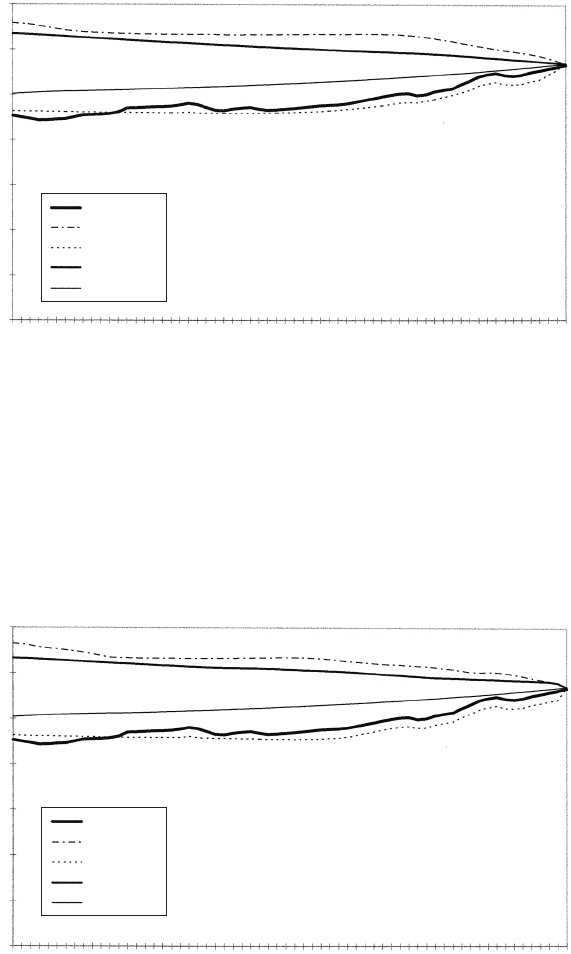
moment of inertia ¼2.7 kg.m
2
was found adequate for the task. Figure
11.2 shows that both maximum and minimum piezometric levels were
improved with minimum head remaining above the pipeline elevation.
In the case of the DUOGLIDE option it was necessary to have a
flywheel with moment of inertia ¼13.5 kg.m
2
before a similar degree
164
0
150
300
450
600
750
900
1050
1200
1350
1500
1650
1800
1950
2100
2250
2400
2550
2700
2850
3000
3150
350
300
250
200
150
100
50
0
Elevation (mAOD)
Chaina
g
e
(
m
)
i.l. (mAOD)
h
max
/0.0
h
min
/0.0
h
max
/2.7
h
min
/2.7
Lawhead/Silverburn rising main. Max. and min. head after trip of Uniglide pump
Fig. 11.2. Envelope curves for trip of UNIGLIDE pumpset
0
150
300
450
600
750
900
1050
1200
1350
1500
1650
1800
1950
2100
2250
2400
2550
2700
2850
3000
3150
350
300
250
200
150
100
50
0
Elevation (mAOD)
Chaina
g
e
(
m
)
i.l. (mAOD)
h
max
/0.0
h
min
/0.0
h
max
/13.5
h
min
/13.5
Lawhead/Silverburn rising main. Max. and min. head after trip of Duoglide pump
Fig. 11.3. Envelope curves for trip of DUOGLIDE pumpset
Pressure transients in water engineering
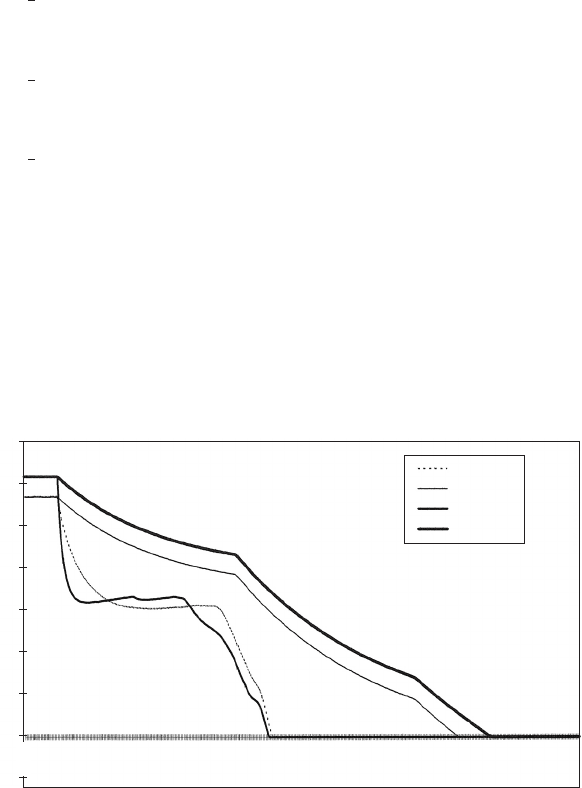
of improvement was achieved. The resulting curves of maximum and
minimum piezomeric level are shown in Fig. 11.3.
The difference of flywheel inertia necessary to achieve the required
improvement is largely due to the difference in operating speed for
the two pumps. The amount of stored energy in the rotating masses
is roughly comparable.
Stored energy E is given by:
E ¼
1
2
I!
2
ð10:4Þ
In the case of the UNIGLIDE pumpset:
E ¼
1
2
ð0:54 þ 2:7Þð2900 2 =60Þ
2
¼ 149 406 N:m
And for the DUOGLIDE pumpset:
E ¼
1
2
ð0:54 þ 13:5Þð1470 2 =60Þ
2
¼ 166 352 N:m
Despite the substantial difference in operating speed the amount of
energy stored is broadly similar.
Velocity variations at the start of the main were as shown in Fig. 11.4.
The pump is tripped at time ¼1 s. It is noticeable that failure of the
DUOGLIDE pump (without flywheel) produces a more rapid decelera-
tion than for the UNIGLIDE (without flywheels) despite the basic
pump þmotor inertia being almost the same. The more gradual
165
Velocity (m/s)
Lawhead/Silverburn rising main. Velocities after trip
Time
(
s
)
SDC/0.0
SDC/2.7
DRA/0.0
DRA/13.5
1.4
1.2
1.0
0.8
0.6
0.4
0.2
0
–0.2
0.041
0.615
1.189
1.763
2.337
2.911
3.485
4.059
4.633
5.207
5.781
6.355
6.929
7.503
8.077
8.651
9.225
9.799
10.373
10.947
11.521
12.095
12.669
13.243
13.817
14.391
14.965
15.539
16.113
Fig. 11.4. Velocities after pumping failure
Flywheels
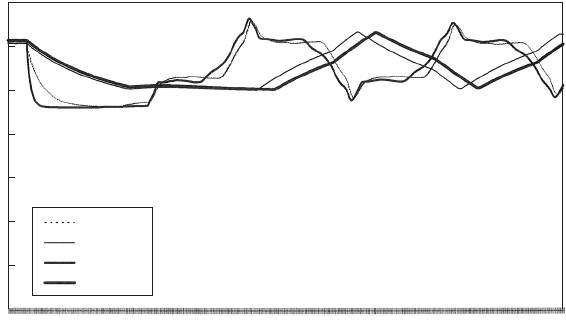
initial deceleration in the case of the UNIGLIDE is again a consequence
of the higher operating speed which gives the UNIGLIDE almost four
times the stored energy of the DUOGLIDE.
A similar effect is to be seen in the time variation of piezometric level
after trip at the start of the rising main (Fig. 11.5). For the DUOGLIDE,
head falls more steeply at first than for the UNIGLIDE. It will be noted
that the head downstream of the DUOGLIDE stabilises after this initial
fall. This is because the head downstream of the pump has now fallen
below the wet well level and the pump has started to turbine.
The variation of velocity below the DUOGLIDE actually increases by
a modest amount, for a time during this pump turbining event (Fig. 11.4).
Due to a more gradual decline in head after trip, the UNIGLIDE starts to
turbine much later and for a shorter time. Arrival of wave reflections from
Silverburn after 4.5 s starts to produce a further stage in the flow
deceleration, leading finally to flow reversal and check valve closure
after 7 s. Head starts to recover after around 7 s (Fig. 11.5). It is inter-
esting to note that if wet well level were lower, then the head down-
stream of the pump would have continued to fall, causing more
severe sub-atmospheric pressures along the pipeline.
When the flywheel is added, the flow deceleration is prolonged (Fig.
11.4) and the decline in piezometric level is also lengthened (Fig. 11.5).
Flow reversal occurs after 12 s for the UNIGLIDE and at almost 14 s for
166
Head (mAOD)
Lawhead/Silverburn rising main. Heads after trip
Time
(
s
)
SDC/0.0
SDC/2.7
DRA/0.0
DRA/13.5
0.041
1.025
2.009
2.993
3.977
4.961
5.945
6.929
7.913
8.897
9.881
10.865
11.849
12.833
13.817
14.801
15.785
16.769
17.753
18.737
19.721
20.705
21.689
22.673
23.657
24.641
25.625
26.609
27.593
28.577
350
300
250
200
150
100
50
0
Fig. 11.5. Head variations after pumping failure
Pressure transients in water engineering
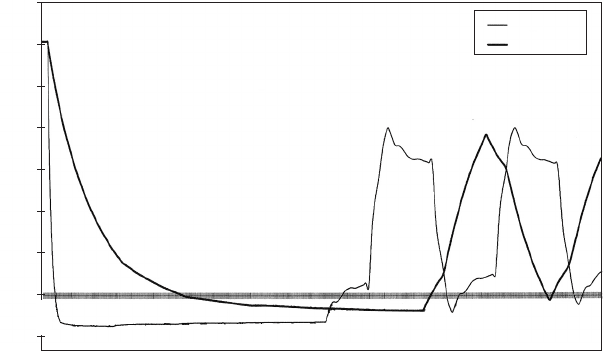
the DUOGLIDE. The pumps do not turbine once the flywheels have
been added, as minimum head is maintained at higher levels than
those within the suction well.
11.6 Flywheels on a larger system
A second example concerns a larger system comprising parallel sewage
rising mains each over 6 km in length. The pipelines from Sharjah
Pumping Station (PS) No. 1 to the treatment works are DN 450 and
DN 700. These mains rise to a peak at chainage 4321 m and an air
valve is sited on each main at this location. Flow rate is an order of
magnitude greater than in the previous example. Speed of the WEIR
PUMPS Ltd, SWALLOWGLIDE type SR400DS was 980 rpm, with a
design head of 34 m. Each of the two duty pumps is rated at
390 litres/s. Suction well level was at 3.182 mASL. A minimum sub-
atmospheric pressure head of 5 mWG, during surge events, was
adopted. Pump moment of inertia was 5.371 kg.m
2
and that of the
motor was 12.5 kg.m
2
. The delivery main leaving the pumping station
was DN 700 with a bifurcation into the DN 450 and DN 700 mains
occurring a short distance from the pumping station.
After two duty pumps were tripped, Fig. 11.6 shows the piezometric
level just downstream of the pumping station, with head falling steeply
167
Head (mASL)
Time
(
s
)
0.0 kg.m
2
255 kg.m
2
Sharjah PS No. 1 head d/s of PS after trip
35
30
25
20
15
10
5
0
–5
0.103
2.781
5.459
8.137
10.815
13.493
16.171
18.849
21.527
24.205
26.883
29.561
32.239
34.917
37.595
40.273
42.951
45.629
48.307
50.985
53.663
56.341
59.019
61.697
64.375
67.053
69.731
72.409
75.087
77.765
80.443
Fig. 11.6. Head variations following pumping failure
Flywheels
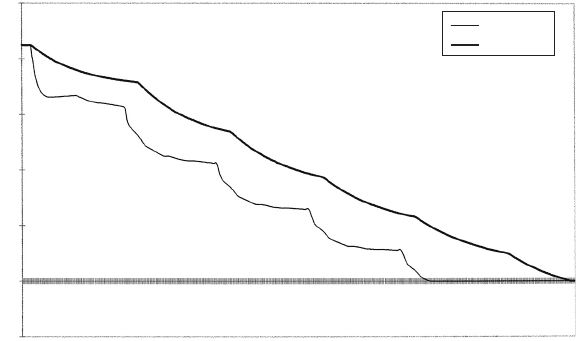
until it is below the sewage level in the suction well. At this time the
pumps begin to turbine and piezometric level downstream of the
pumps is largely stabilised by continued flow from the suction well.
This continues until around 40 s have elapsed when flow finally
ceases and check valves close. Flow reversal along the mains produces
a modest head rise and a fairly regular oscillation.
Figure 11.7 shows the corresponding velocity variation in the DN
700 line leaving the pumping station. Flow declines in a stepped
manner, with each wave reflection from the treatment works producing
a further reduction in flow until check valve closure.
Notwithstanding the stabilising effect of the suction well and pumps’
turbining, Fig. 11.8 shows that the entire length of pipelines up until the
summit at chainage 4321 m is subject to severe sub-atmospheric pres-
sure. Operation of the air valves at this high point alleviates conditions
between this summit and the treatment works.
The minimum pressures predicted were unacceptable and a flywheel
having inertia ¼255 kg.m
2
was added to each pump. Subsequent
predictions after failure of the pumps produced a more gradual fall in
piezometric level downstream of the pumps (Fig. 11.6), with
minimum head remaining above suction well level. Flow reversal
occurred around 56 s with pumps tripped at time ¼1 s. After check
valves shut, subsequent peak pressures were below the steady
168
Velocity (m/s)
Time (s)
0.0 kg.m
2
255 kg.m
2
Sharjah PS No. 1 trip of pumps. Velocity d/s of PS
2.5
2.0
1.5
1.0
0.5
0
–0.5
0.103
2.060
4.017
5.974
7.931
9.888
11.845
13.802
15.759
17.716
19.673
21.630
23.587
25.544
27.501
29.458
31.415
33.372
35.329
37.286
39.243
41.200
43.157
45.114
47.071
49.028
50.985
52.942
54.899
Fig. 11.7. Velocity changes after pumping failure
Pressure transients in water engineering
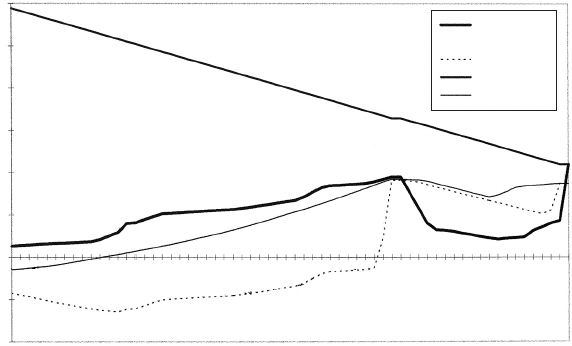
pumping levels. Velocity variations in Fig. 11.7 show a smoother
deceleration with the flywheels added. Minimum piezometric levels
along the mains (Fig. 11.8) show an improvement with an almost
linear variation of head from the pumping station until the summit at
chainage 4321 m. Minimum pressure head was above the 5 mWG
allowable limit.
The air valves have acted as a secondary form of protection against
low pressures but at the price of admitting substantial quantities of
air to the mains. Figure 11.9 shows the anticipated quantities of air
drawn into each pipeline with and without flywheels. Including the
flywheels has the effect of reducing the volume of air by almost 2 m
3
in each main. Since there is a relatively small difference in level
between the summit at chainage 4321 m and the level of sewage in
the pipeline leading up to the treatment works inlet, it was predicted
that much of the air admitted would remain in the pipelines. When
pumps are restarted, air will be purged and it is important to have
safe rates of expulsion if undesirable hydraulic transient effects are to
be avoided when the air valves shut.
This case has shown that the size of flywheel necessary can increase
considerably when flow rate, pipe length and diameter increase and
when pump speed is relatively low. For instance, if pump speed had
been 1470 rpm then the necessary moment of inertia of flywheel
would have been closer to 100 kg.m
2
. Providing pump start measures
169
0
301.5
603.0
904.5
1206.0
1507.5
1809.0
2110.5
2411.9
2713.4
3014.9
3316.4
3617.9
3919.4
4220.9
4422.3
4725.2
5028.0
5330.8
5633.6
5936.4
6144.9
Chaina
g
e (m)
Elevation (mASL)
Sharjah PS No. 1 max. and min. head following pumping failure DN 450 main
30
25
20
15
10
5
0
-5
–10
i.l. (mASL)
h
max
/0.0
h
min
/0.0
h
max
/255
h
min
/255
Fig. 11.8. Envelope curves after pumping failure for DN 450 main
Flywheels
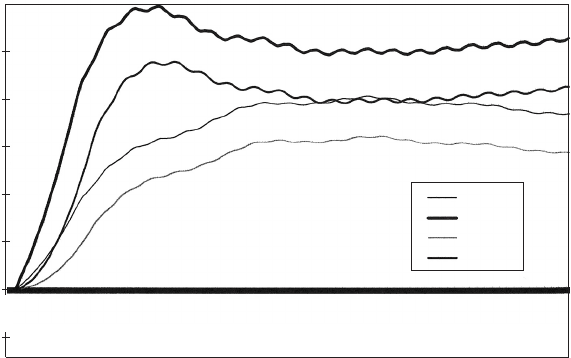
will allow, this example has also illustrated how a flywheel can be
considered for larger schemes, acting in conjunction with other forms
of alleviation, to provide an overall package of protection measures.
11.7 Booster pump installations
In the case of a booster pump fitted with a flywheel, then following a
pumping failure hydraulic transient behaviour is benefited both
upstream and downstream of the pumping station. This is because
deceleration dV=dt is controlled at its source — that is, at the pump.
This changing rate of flow applies both upstream and downstream of
the pumping station. Along a suction main the effect of the flywheel
is to suppress the peak transient pressures which would otherwise
occur following a pumping failure.
11.8 Multi-pump installations
For multi-pump installations it is important to note that the amount of
protection varies in proportion with the number of operating pumps,
whereas the incremental increase in flow rate obtained by adding
each additional pump becomes smaller. Extreme hydraulic transient
pressures after a pumping failure may not necessarily follow failure of
170
12
10
8
6
4
2
0
–2
Sharjah PS No. 1 air volumes around ch. 4321 m after pumps are tripped
Volume (m
3
)
Time (s)
450/0.0
700/0.0
450/255
700/255
0.103
13.081
26.059
39.037
52.015
64.993
77.971
90.948
103.926
116.904
129.881
142.859
155.836
168.814
181.792
194.769
207.747
220.724
233.702
246.680
259.657
272.635
285.612
298.590
311.568
324.545
337.523
350.500
363.478
376.456
389.433
Fig. 11.9. Air volumes in mains after pumping failure
Pressure transients in water engineering

the maximum number of operating pumps but may result from trip of a
lesser number of units.
11.9 Advantages of flywheels
Advantages of the flywheel solution are: relatively lower cost as far as
initial purchase is concerned; simplicity; control of the surge at its
source; quieter check valve closure; control of surging both upstream
and downstream in the case of a booster pump; and no restriction as
far as the type of liquid being conveyed.
Appendix Moment of inertia
A body in linear motion has a kinetic energy ¼
1
2
mass velocity
2
. Con-
sider a solid disk of material of density
d
having diameter D, thickness t
and rotating with angular velocity ! as shown in Fig. A11.1. A segment
of this disk is at a distance r from the centre and occupies an area
dr r d as shown in the figure. The kinetic energy dE of this elemen-
tary segment of material will be dE ¼
1
2
mass velocity
2
.
Alternatively, the kinetic energy can be expressed as:
dE ¼
1
2
d
drrd tV
2
since, V ¼ !r kinetic energy can be written:
dE ¼
1
2
d
drrd tð!rÞ
2
¼
1
2
d
t!
2
r
3
dr d
Integrating over the entire disk then, total kinetic energy of the rotating
body will be given by:
E ¼
1
2
d
t!
2
ÐÐ
r
3
dr d
With the limits of integration being, 0 r D=2 and 0 2, this
gives:
E ¼
1
2
d
t!
2
1
4
ðD=2Þ
4
4=2 ¼
1
2
d
t!
2
D
4
=32
or,
E ¼
1
2
f
d
tD
4
=32g!
2
¼
1
2
I!
2
ðA10:1Þ
where I is called the moment of inertia of the rotating mass. The
moment of inertia of a more complicated rotating body is obtained by
summing the individual moments for each part. In the case of an
electrically driven turbine pumpset this will comprise the rotor of the
171
Flywheels
